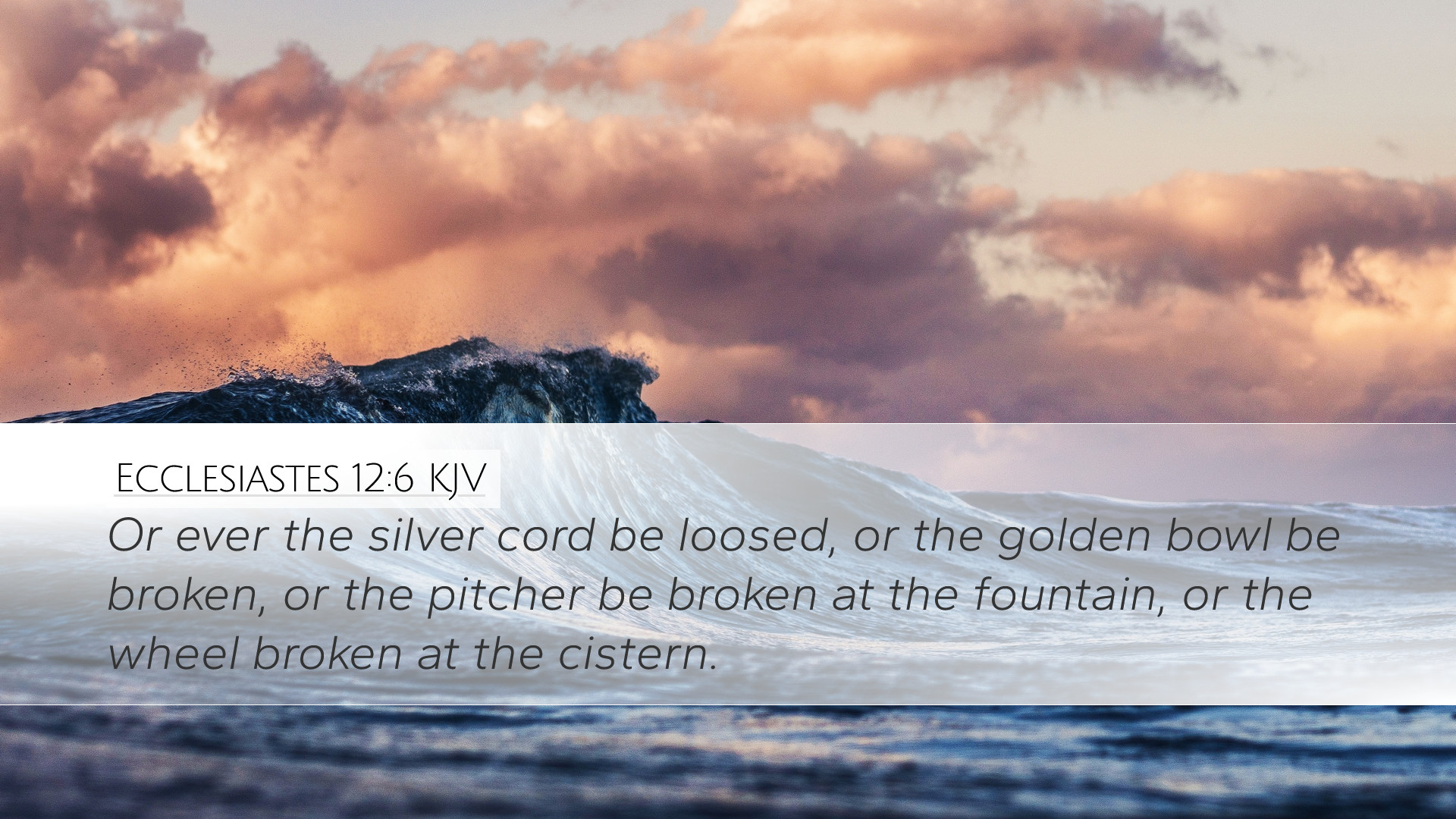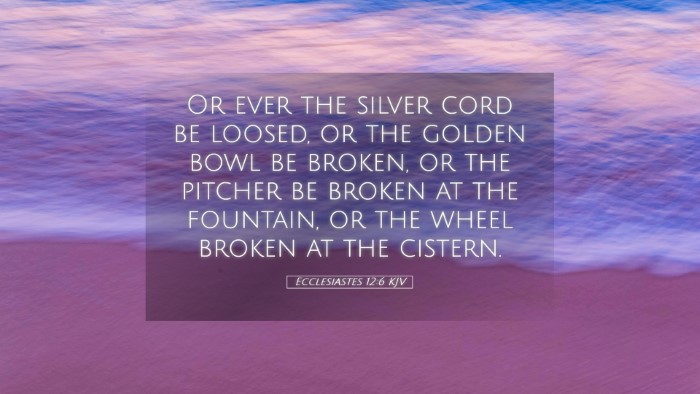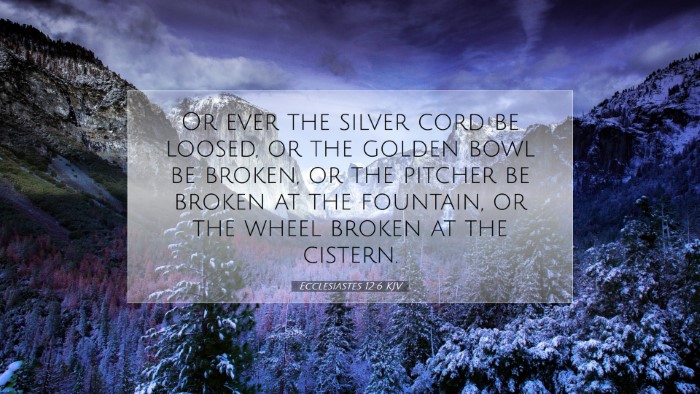Old Testament
Genesis Exodus Leviticus Numbers Deuteronomy Joshua Judges Ruth 1 Samuel 2 Samuel 1 Kings 2 Kings 1 Chronicles 2 Chronicles Ezra Nehemiah Esther Job Psalms Proverbs Ecclesiastes Song of Solomon Isaiah Jeremiah Lamentations Ezekiel Daniel Hosea Joel Amos Obadiah Jonah Micah Nahum Habakkuk Zephaniah Haggai Zechariah MalachiEcclesiastes 12:6
Ecclesiastes 12:6 KJV
Or ever the silver cord be loosed, or the golden bowl be broken, or the pitcher be broken at the fountain, or the wheel broken at the cistern.
Ecclesiastes 12:6 Bible Commentary
Commentary on Ecclesiastes 12:6
Verse: "Before the silver cord is loosed, or the golden bowl be broken, or the pitcher be broken at the fountain, or the wheel broken at the cistern," (Ecclesiastes 12:6, KJV)
Introduction
The final chapter of Ecclesiastes culminates in a poignant reflection on the fragility of life. This verse serves as a vehicle for the author, traditionally understood as Solomon, to depict the inevitability of death and the ultimate fate that awaits all humanity. Various public domain commentaries offer profound insights into the metaphoric language and theological implications of this text. Through the synthesis of Matthew Henry, Albert Barnes, and Adam Clarke, we explore the implications of what it means to be reminded of our mortality.
Contextual Analysis
The preceding verses in Ecclesiastes emphasize the fleeting nature of youth and the importance of remembering one's Creator. Verse 6 functions as a metaphorical summation of human existence, using imagery that reflects the stages and conditions of life that eventually lead to its cessation. As we delve into each metaphor, we can uncover nuanced meanings pertinent to pastoral care, scholarly reflection, and the daily lives of Christians.
Metaphors Explained
-
The Silver Cord
Matthew Henry articulates that the "silver cord" represents the attachment between the soul and the body. When this cord is loosened, it signifies physical death. This imagery calls attention to the preciousness of life and the impending reality of separation from the earthly vessel.
-
The Golden Bowl
Albert Barnes elaborates on the "golden bowl" as a vessel that reflects both beauty and fragility. The breaking of this bowl suggests a loss of beauty and wholeness, symbolizing how life, once vibrant and cherished, can disintegrate. This metaphor serves to remind believers of the transient nature of joy and vitality.
-
The Pitcher at the Fountain
Adam Clarke notes that the "pitcher" is essential for drawing water, essential for sustaining life. The breaking of this pitcher symbolizes the loss of sustenance, both physical and spiritual. It speaks to the inevitability of life’s sources being cut off, urging believers to reflect on their dependence on God.
-
The Wheel at the Cistern
Matthew Henry connects the "wheel" to the mechanisms that draw water—an essential process for sustaining life. The imagery of the wheel breaking reinforces the idea that life cannot continue in its natural order without divine assistance, emphasizing God's sovereignty over life and death.
Lessons on Mortality
Ecclesiastes 12:6 compels us to reflect on our mortality and the brevity of life. These metaphors encapsulate the essential truths that pastors, theologians, and students must grapple with in their ministries and studies.
-
The Reality of Death
Each of the described elements ultimately faces destruction, serving as a metaphor for human life. This reality should propel believers to live with intentionality, focusing on eternal values and the legacy they leave behind.
-
The Value of the Present
Henry emphasizes the urgency of living life in light of its fleeting nature. The time to enjoy life and to honor God is now—for tomorrow is not guaranteed. This understanding encourages present-minded living that appreciates the daily gifts of God.
-
The Call to Comprehension
Barnes insists that the imagery invites an understanding of life as a delicate balance between joy and suffering. Recognizing the breaks in our own lives—whether through loss, disappointment, or conflict—invites a posture of wisdom and reliance on God.
-
The Encouragement of Hope
Despite the somber nature of the verse, there lies a thread of hope in acknowledging death as a transition rather than an end. Clarke points out that such reflections should lead believers to seek the eternal joy promised in Christ, affirming life beyond the grave.
Conclusion
Ecclesiastes 12:6 serves as both a sobering reminder and an impetus for believers to reflect on the temporality of life. Through the insights of Matthew Henry, Albert Barnes, and Adam Clarke, we can glean deep theological truths that emphasize our urgent call to remember our Creator and live wisely within the constraints of our mortal existence. This verse is a potent reminder that while life is fragile and fleeting, the decisions we make can resonate throughout eternity.


